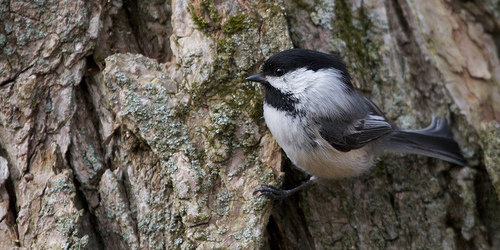We know that squirrels make the most of fall’s plenty by hoarding nuts for the winter, but the fact that birds also store, or cache, food goes largely unappreciated. Through clever observation and experiments, biologists have found that food caching (from the French cacher, “to hide”) has developed to a high art in some birds.
Take the chickadee, for instance. Chickadees put tens of thousands of food items a year into short-term storage. They usually retrieve and eat the food in the space of several days. Each food item is cached in a different place to make it difficult for thieves to steal all the food at once. When hiding a new item, they remember their previous storage sites and avoid placing caches too close together.

The Black-Capped Chickadee hides seeds and other food items to eat later. Each item is placed in a different spot and the chickadee can remember thousands of hiding places.
Chickadees remember each hiding place for around a month, even though they may be scattered widely across a bird’s territory. Research shows they use visual cues to navigate back to each of their cache sites by a combination of larger landscape features, particularly verticals, and use of the sun as compass. Smaller local details are not as critical, probably because these often change in a forest. When retrieving food, they remember which sites have been emptied, either by them or by robbers, to avoid fruitless searching.
How does a tiny bird have such brain power?
Chickadees begin to store food at the onset of fall, when seeds become abundant. At the same time, the region of the brain that handles spatial memory (part of the hippocampus) starts to grow in size by producing new brain cells to handle the huge amount of cache data. It continues to grow as more food is cached. Come spring, reliance on food stores drops, caching dwindles, and the brain area shrinks. Brain cells use a lot of energy, so to conserve resources the extra cells last only as long as they are needed. Brain growth is tied to food availability, since captive chickadees that receive plentiful food year-round do not undergo seasonal brain changes…
(Read whole article by Li Shen, an adjunct professor at the Dartmouth Medical School and the chair of the Thetford, Vermont, Conservation Commission)
Image by qmnonic
If you enjoyed this post, please consider leaving a comment and subscribing by RSS feed or via email to have future articles delivered to you.
Discover more from Vermont Birder
Subscribe to get the latest posts sent to your email.
